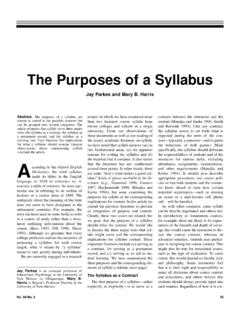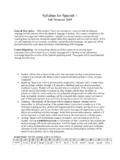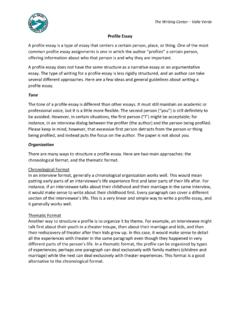Transcription of A Unified Approach to Questions, Quantifiers, and ...
1 A Unified Approach to Questions, Quantifiers, and coordination inJapaneseKatsuaki NakanishiDepartment of Language and Information Sciences University of TokyoProceedings of the 13th International Conference onHead-Driven Phrase Structure GrammarLinguistic Modelling Laboratory,Institute for Parallel Processing,Bulgarian Academy of Sciences,Sofia,Held in VarnaStefan M uller (Editor)2006 CSLI Publicationspages 268 283 , Katsuaki. 2006. A Unified Approach to Questions, Quantifiers, andCoordination in Japanese. In M uller, Stefan (Ed.),Proceedings of the 13th Inter-national Conference on Head-Driven Phrase Structure Grammar, Varna, 268 , CA: CSLI Japanese language is one of the languages where universal and exis-tential quantification are expressed usingwh-words with the conjunctive anddisjunctive particles, respectively.
2 In this paper, inspired by the syntactic andsemantic parallelism found in Japanese between quantification, coordination ,and question , we seek to analyze these constructions in a unified fashion. Weinvestigate various phenomena of these constructions and show how thesethree constructions can be uniformly analyzed as cases where abstracted ar-guments are questioned or quantified for verbs. We then present an HPSG formalization of the IntroductionUniversal/existential quantifiers can be seen as generalization of logicalconjunc-tion/disjunction. The universal (existential) quantification of an open propositionis the conjunction (disjunction) of all its possible instantiations.
3 In other words,conjunction (disjunction) is a special kind of universal (existential) quantificationwhere the domain of the variable is restricted to the set of the conjuncts (disjuncts).The Japanese language seems to reflect this well-known logical relationship. Acommon way in Japanese to express universal or existential quantificationis touse awh-pronoun in combination withmoorka, particles otherwise used to de-note conjunction or disjunction (Let s call this quantificationwh-mo/ka).1 Actually,there is a strong parallelism between these two uses of the particles:(1) a. Kare-wa ie-de-mogakkou-de-mo He played at home and at school.
4 B. Kare-wa He played everywhere. c. Kare-wa ie-kagakkou-(ka)-de He played at home or at school. d. Kare-wa He played somewhere. Examples (1b) and (1d) are examples of universal and existential quantification,respectively. In (1b), thewh-worddoko where is marked bymo, and it means1 There are other languages where universal/existential quantification is expressed by awh-wordand a conjunctive/disjunctive particle (see, for example, Gill et al. (2004)). This suggests that the useof conjunctive and disjunctive particles in universal and existential quantification in Japanese is notjust a coincidence but a typological everywhere.
5 In (1d),dokois marked byka, and it means somewhere . Examples(1a) and (1c) are examples of conjunctive and disjunctive coordination . As you cansee, syntactically, (1a) and (1c) are the same as (1b) and (1d), respectively, exceptthat themo/ka-marked argument are repeated several times (2 times in this case)and in each case, thewh-word is replaced by a different individual. This syntacticcorrespondence between (1a, c) and (1b, d) is parallel with the semanticcorre-spondence between these examples because, as the above-mentioned logical re-lationship between universal/existential quantification and conjunctive/disjunctivecoordination suggests, the denotations of (1a) and (1c) are the same as those of(1b) and (1d), respectively, except that the domain of the variable is restricted tothe set of what are thewh-words doing in the quantified sentences (1b, d)?
6 Accord-ing to Ginzburg and Sag (2001) (henceforth GS) s semantic ontology, on whichthey base their HPSG account of English interrogatives, questions are proposi-tional abstracts wherewh-words correspond to abstracted arguments. If, in (1b, d),thewh-words are notmo/ka-marked and the verb is in the interrogative form, wehave an ordinarywh- question :(2) Kare-wa doko-deasonda-ka?he-TOPwhere-LOCplayed-Q Where did he play? and its denotation, in GS s view, is(3) {x}[[he played atx]]Note here that (3) is the very open proposition which is quantified in (1b, d).The relationship between the three constructions in question , namely question ,quantification, and coordination in Japanese, is informally summarized in Figure 1,which shows the semantic relationship, what syntactic elements each constructionconsists of, and how these syntactic elements are shared between these relationship leads us to think that the semantics of questions, quantifiersand coordination in Japanese should be consistently accounted for by thesemanticcontributions of the particlesmo/kaand ofwh-words.
7 In the following, we showhow such an analysis can be implemented in FrameworkBefore proceeding with the analysis, let us first outline our general frameworkfor representing the semantics of question and quantification and for identifying2 Hagstrom (1998) further identified the disjunctive particlekawith the question markerkaandtried to analyze them uniformly as existential quantification over choice functions. We do not takethis view, however, because the disjunctive particlekaand the question markerkaare a nominalsuffix and a suffix to finite verbs, respectively, and thus we consider that they are different lexicalentries belonging to different syntactic categories that happen to have thesame coordination syntax: mo/ka syntax: mo/ka wh semantics: / x.
8 Semantics: / x {..},.. question Domain Restriction syntax: wh Quantification question marker semantics: {x},.. Figure 1: Syntactic/semantic relationship between the three constructionsmo/ka-marked words in HPSG. Our general semantic framework follows that ofGS s, but with some modifications. In this section, we first explain our adapta-tion of GS s framework, and then we introduce a feature to and Sag (2001) s semantic frameworkGS introduced a separate semantic type, question , for the contents of interrog-ative clauses. The typequestionhas the featurePARAMS, thewh-phrase ana-logue ofQUANTS (Ginzburg and Sag 2001:121), whose value is a set ofparams, restriction-bearing indices (Ginzburg and Sag 2001:121), which correspond tothe abstracted arguments of the propositional abstract thewh-words in the their framework, questions are semantically distinguished from other clauses bytheir contents being of typequestion.
9 Thus, even polar questions, questions with noarguments abstracted, can be distinguished as questions, only with treatment of polar questions, however, is not without problems. GS de-fine the conjunction of two propositional abstracts as follows (Ginzburg and Sag2001:110):Given a questionq1(= A. ) and a questionq2(= B. ), whereA B= : ( A. , B. ) =def A B. { , }( A. denotes the propositional abstract whose set of abstracted argument isAand whose corresponding proposition is ) That is, as the conjunction of the cor-responding propositions with the set of abstracted arguments being the union ofthe sets of abstracted arguments of the conjuncts.
10 But in this way, since a polarquestion is a propositional abstract whose set of abstracted parametersis the emptyset and the union of a set with the empty set is the original set itself, if you conjoin271a polar question with another question , the information that the truth value of thecorresponding proposition of the polar question is asked is lost. For example, thedenotation of (4a) and (4b) will be the same, that is, (4c).(4) a. whether it is good and whether it is cheapb. whether it is good and cheapc. {}(Good(i) Cheap(i))d. {p1, p2}(Good(i, p1) Cheap(i, p2))e. {p}(Good(i, p) Cheap(i, p))One way to solve this problem is to regard the polarity as an argument and toabstract it in polar questions, instead of identifying polar questions as propositionalabstracts with example, if Good and Cheap in (4) havethe polarity argument as their second arguments, the denotation of (4a) and(4b)are distinguished as (4d) and (4e), implement this solution, in our framework, the typerel(ation)has the fea-turePOL(ARITY), whose value is of typeindex.



















